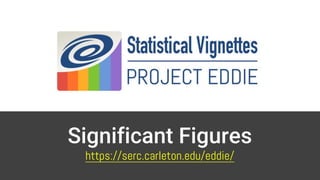
StatVignette03_Sig.Figs_v04_07_15_2020.pptx
- 2. Learning Objectives After completing this vignette, a student should be able to: • Apply the rules of significant figures for a measurement • Express numerical values with the correct number of significant figures using a mnemonic device (the "Atlantic Pacific Rule") 2 • Determine the number of significant figures from a given value or mathematical operation Chang, R and Goldsby, K. (2013). Chemistry. 11th ed. McGraw-Hill Education, pp.19-23.
- 3. How tall is Emerson the Giraffe?
- 4. What if you use a different ruler to measure Emerson? Does it make a difference?
- 5. What are Significant Figures? 1 • The “important digits” of a number • They tell us about the precision of the underlying measurement • Important in the final answer
- 6. The precision of your measuring device impacts how many significant figures should be reported. Ruler 1: 5.50 m Ruler 2: 5.5 m
- 7. Leading and Trailing Zeros 1 Leading Zeros to the left of the first nonzero digit are not significant Trailing If the 1st digit is > 1, then zeros to the right of the decimal point are significant If a digit is < 1, then only the zeros at the end and the zeros in-between non- zeros are significant 0.000205 3 Sig Figs 60.090 5 Sig Figs 0.04050 4 Sig Figs
- 8. General Rules 1 • All leading non-zero digits are significant, if there are no digits after a decimal point. • Zeros between nonzero digits are significant • Leading zeros are never significant • Trailing zeros in the decimal portion are significant 6500 9004 0.0064 0.03400 Chang, R and Goldsby, K. (2013). Chemistry. 11th ed. McGraw-Hill Education, pp.19-23.
- 9. How many Sig. Figs are present? 6500 = ? 9004 = ? 0.0064 = ? 0.03400 = ?
- 10. Here are the answers! 6500 = 2 9004 = 4 0.0064 = 2 0.03400 = 4
- 11. Atlantic – Pacific Rule 2 Read values from left to right. All numbers from the first non- zero are significant → 1.270 4 Sig. Figs! Read values from right to left All numbers from the first non-zero are significant 12700 ← 3 Sig. Figs! For counting significant figures Pacific Decimal is Present Atlantic Decimal is Absent Stone, Helen M. Atlantic-Pacific sig figs. Journal of Chemical Education 66.10 (1989): 829. https://www.sas.upenn.edu/~dbalmer/eportfolio/sigfig_article.pdf
- 12. Decimal Precision: When to round 1st Rule: Round up the digit that follow if the first digit in front is less than 5. 17.53 rounds off to 17.5 17.5 = 3 Significant Figures 2nd Rule: If the digit is equal or greater than 5, the digit is rounded up by 1. 17.55 rounds up to 17.6 17.6 = 3 significant Figures
- 13. Addition/Subtraction 1 • Wait to round until the end of the calculation • Round final answer to match the number with the fewest decimal significant figures 10. 1 ← 1 decimal place + 7. 43 ← 2 decimal places 17. 53 17.5 ← Final number 3 Sig. Figs (Rounded to 1 decimal place) Chang, R and Goldsby, K. (2013). Chemistry. 11th ed. McGraw-Hill Education, pp.19-23.
- 14. Multiplication/Division 1 • Wait to round until the end of the calculation • Round final answer to match the number with the fewest decimal significant figures 1.5 ← ? Sig. Figs 4.93 ← ? Sig. Figs x 6.027 ← ? Sig. Figs 45 ← ? Sig. Figs Chang, R and Goldsby, K. (2013). Chemistry. 11th ed. McGraw-Hill Education, pp.19-23.
- 15. Multiplication/Division 1 • Wait to round until the end of the calculation • Round final answer to match the number with the fewest decimal significant figures 1.5 ← 2 Sig. Figs 4.93 ← 3 Sig. Figs x 6.027 ← 4 Sig. Figs 44.5697 ← Round 45 ← 2 Sig. Figs Chang, R and Goldsby, K. (2013). Chemistry. 11th ed. McGraw-Hill Education, pp.19-23.
- 20. Take Home Messages! Significant figures are important - they tell us about the precision of the underlying measurement Final answer should not be more precise than the least precise measurement used in the calculation.